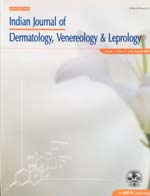
|
Indian Journal of Dermatology, Venereology and Leprology
Medknow Publications on behalf of The Indian Association of Dermatologists, Venereologists and Leprologists (IADVL)
ISSN: 0378-6323
EISSN: 0378-6323
Vol. 72, No. 3, 2006, pp. 201-202
|
 Bioline Code: dv06067
Bioline Code: dv06067
Full paper language: English
Document type: Research Article
Document available free of charge
|
|
|
Indian Journal of Dermatology, Venereology and Leprology, Vol. 72, No. 3, 2006, pp. 201-202
| en |
Achieving asepsis of banana leaves for the management of toxic epidermal necrolysis
Srinivas CR, Sundaram VShanmuga, Raju BAppala, Prabhu SKarthick, Thirumurthy M, Bhaskar AC
Abstract
Background: Banana leaf is used in many centers in India during the care of patients with toxic epidermal necrolysis (TEN) and other extensive blistering disorders. Sepsis is an important cause of death in TEN patients and use of banana leaf may be a source of such infection.
Aims: We conducted this study to detect the bacterial flora of the banana leaf and to examine various methods of rendering the leaf aseptic.
Methods: Five pieces of banana leaf, 2 x 2 cm in size, were cultured separately in blood agar as follows: One piece was heated over a flame and one was soaked in boiling water and one was autoclaved. Methylated spirit was applied over one piece and ignited. One piece was placed on the media, 'as is.' The Petri dishes were incubated examined after 48 h.
Results: All the pieces except the autoclaved specimen of the leaf grew coagulase-negative staphylococci (CONS) when aseptic precautions were not maintained and aerobic spore bearers when all aseptic measures were subsequently instituted during the procedure.
Conclusion: We recommend measures to prevent possible transmission of bacterial infection by the leaf. Autoclaved and aseptically handled banana leaves may be used to reduce chance of infection in the treatment of TEN.
Keywords
Banana leaf, toxic epidermal necrolysis
|
| |
© Copyright 2006 Indian Journal of Dermatology, Venereology and Leprology.
Alternative site location: http://www.ijdvl.com
|
|
